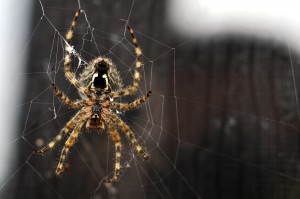
“Seeing a spider is nothing. It becomes a problem when it disappears.”
BEWARE: some creepy crawlies that come into your home and yard are poisonous to your pet. Three of the most common and dangerous insect pests found in the Triangle area are:
black widows, brown recluse and fire ants. The two spiders will not bite unless provoked. The fire ants, however, will travel up your leg if you stand near their ant mound and are aggressive.
1. The Black Widow spider is one of the more infamous spiders, recognized by the shiny black body with a red hourglass shape on the abdomen. She is also known for eating the male after mating. The bite of an adult female black widow spider can be fatal, and they are most aggressive when they are protecting an egg sac. The male black widow spider is much smaller and not dangerous.
“The first sign is sharp pain at the site of the bite. Later the dog develops intense excitability, fever, weakness, and muscle and joint pains. Seizures, shock, and death can occur, especially with the bite of the black widow spider. An antivenin is available to treat these bites.” Pet Web MD.
2. The Recluse spider – Brown recluses are small, with evenly colored legs void of stripes or spines. A few species have a marking shaped like a violin on them. They are nocturnal and prefer to hide in crawl spaces, wood piles, or under house porches/decks. Bites occur when an animal rolls over in its sleep on top of a prowling recluse, or unintentionally disturbs the spiders resting place.
“Reaction typically occurs at the site of the bite, with an ulcerated necrotic wound that results in the death of the surrounding soft tissue. The wound is slow to heal, leaving an open wound that is at risk of further infection.” – Pet MD
3. Fire Ants – Are aggressive and have an intensely painful and burning sting. If you accidently walk on their mound, they will swarm. “The stings cause a painful wound that turns into a pustule, which can become infected and tends to itch while it heals.” -Virginia State.
To treat their bite, you can pick up an antihistamine from the vet or pet store to help. Calamine lotion applied right to the bites can also soothe your pet.
Another bug you don’t want to handle is the Millipede with bright yellow color patterns. It secretes a compound containing cyanide. It is found in parks and on trails in wooded areas. The sting causes a local reaction at site, and depending on the size of your dog, can be a minor irritation or more serious. A paste made of baking soda and water can be applied right to the site.
Some websites list insects alphabetically, with a close-up photo to aide with identification. There are brief summaries attached, or you can click on the insect name for an in-depth report that includes their habitat, life cycle, and if they are poisonous. Click this link to try it out:
http://www.insectidentification.org/insects-by-state.asp?thisState=North+Carolina
Another good guide that has both thumbnail and larger photos to reference identification:
http://bugguide.net/node/view/28627










